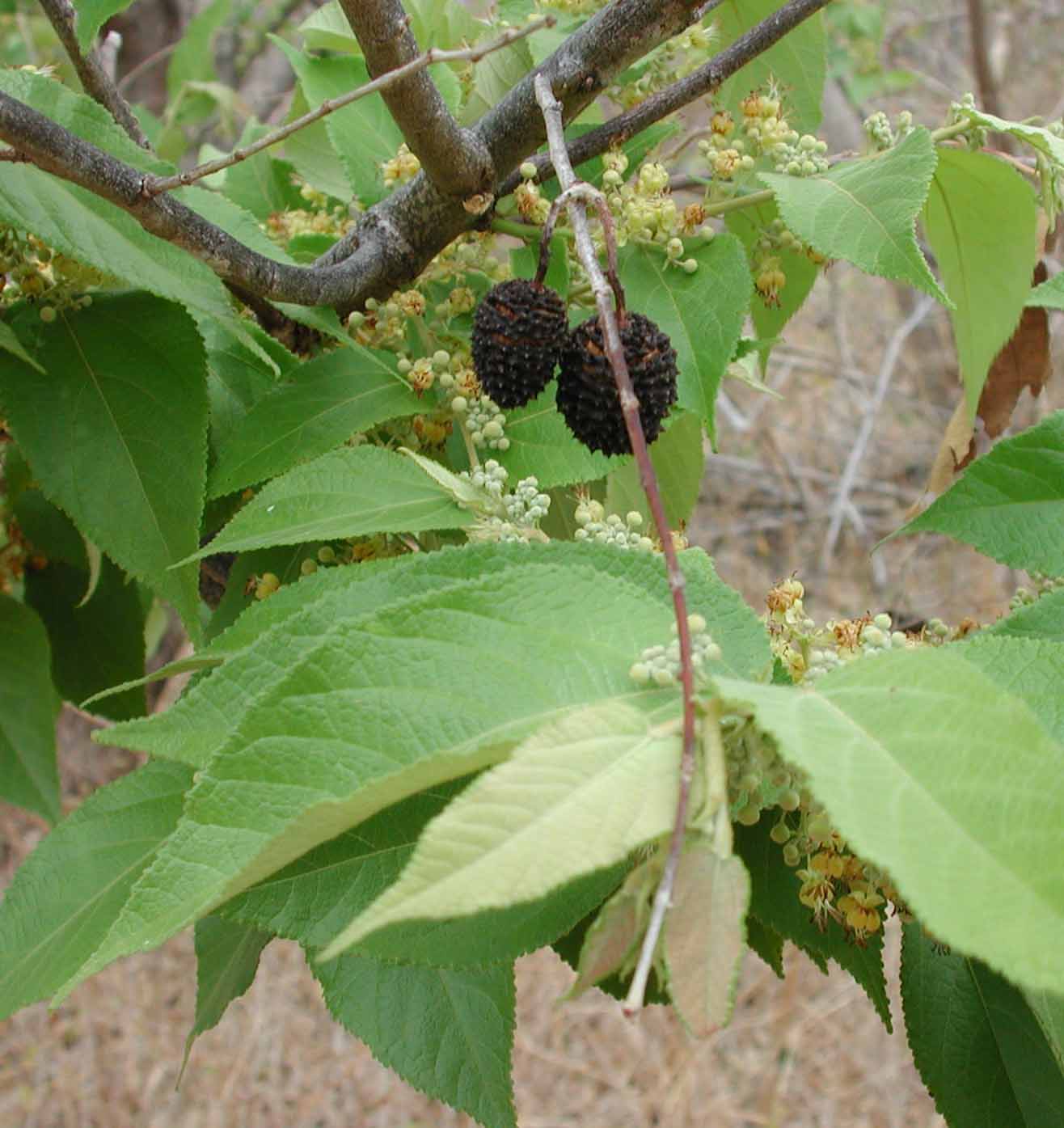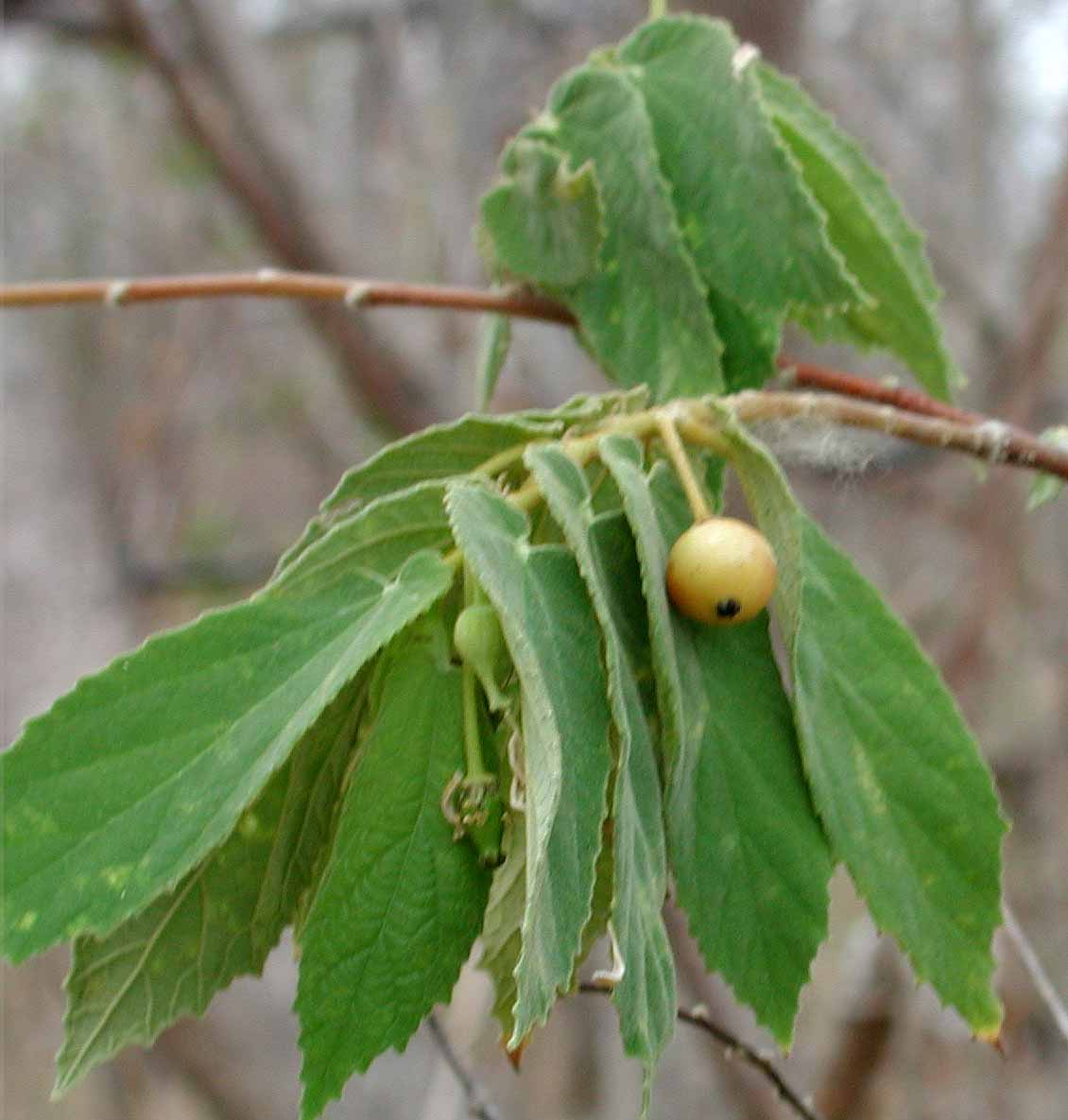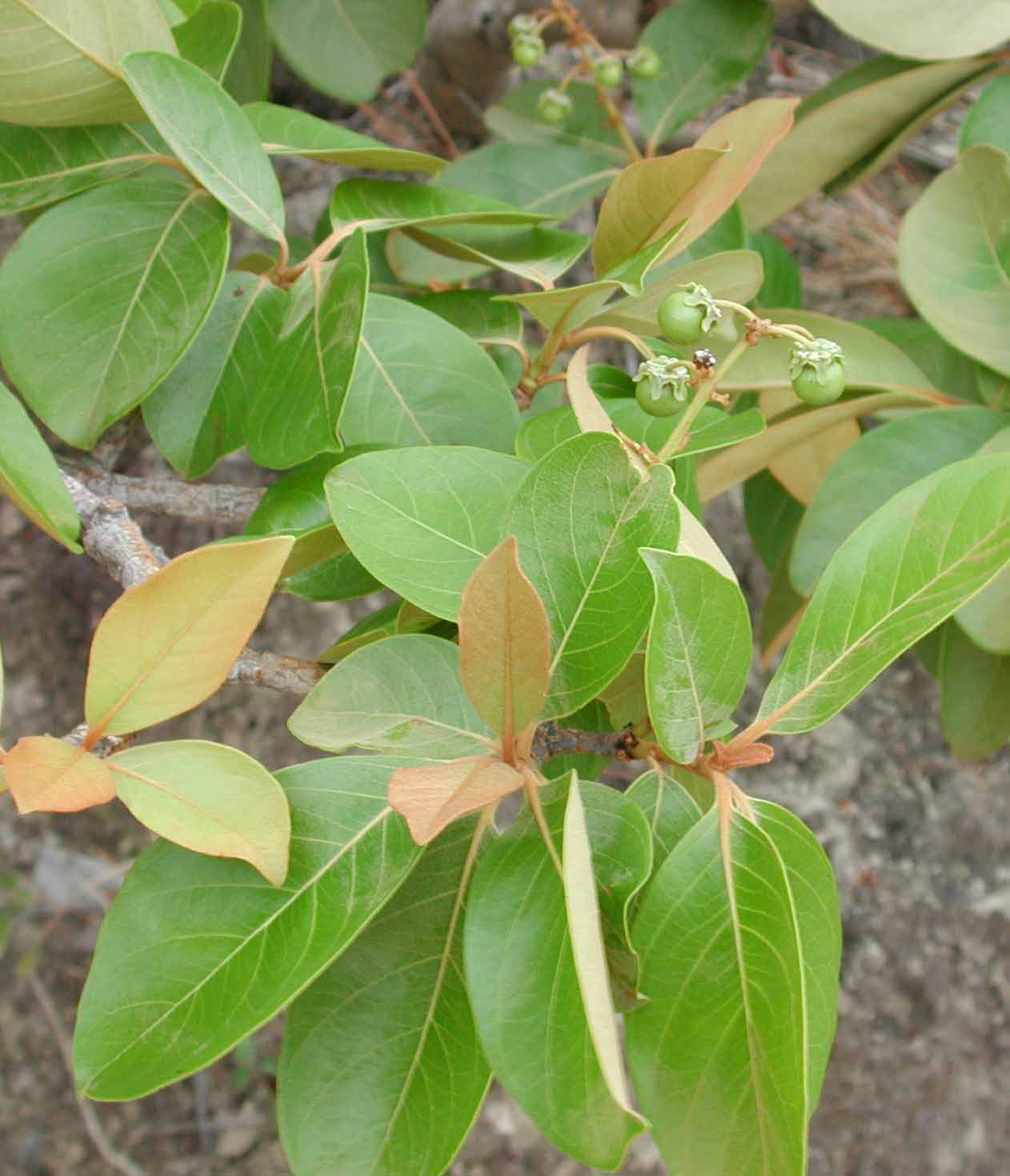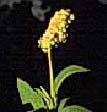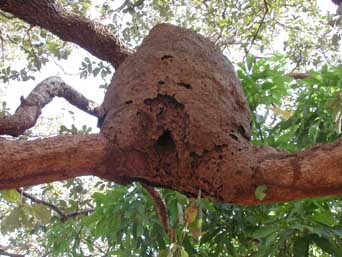This 80 g parrot is extremely common throughout the lowland ACG. In flight, it is easily recognized by its long pointed tail and aerial dexterity. All of the other common parrot species in the ACG have shorter tails and tend to avoid sudden turns and twists in flight. When perched, look for the orange patch over the beak, and the yellow to pale-yellow eye ring. Older birds have more orange over the beak, yellower eye rings, and dark plumage around the base of the beak. The two sexes are identical in appearance. |
Orange-fronted Conures are a common member of the dry tropical forest community that extends along the west coast of Central America from Sinaloa, Mexico to the southern edges of Guanacaste, Costa Rica. They favor open and broken woodlands and savannahs, but will visit the canopy of closed deciduous forest |
| Natural History: Diet:These parrots eat a wide variety of flowers, seeds and fruit as the seasons change. Some major items in the diet: | Species | Season | | | Guazuma ulmifolia seeds | Dry | | | Gliricidia sepium ovaries and flowers | Dry | | | Lonchocarpus minimiflorus fruits | Dry | | | Muntingia calabura fruits | Wet & Dry | | | Nancite (Byrsonima crassifolia) fruit | Wet | | | Cordia guancastensis seeds & pericarp | Wet | | | Bursera tomentosa fruits | Wet | | | Night Roosts: Orange-fronted Conures typically change night roosts every night. This does not necessarily mean that a large and popular roost will be untenanted on a given evening, but instead that the birds using that site tend to be different on successive nights. Some night roosts may house up to a 100 birds. More typically, several foraging flocks of 20 birds each will join during the late afternoon staging and then sleep together in a single tree. The most popular Conure sleeping tree in the SSR during the rainy season is the Poro Poro tree (Cochlospermum vitifolium). These small to medium trees have dense foliage that provides excellent concealment for sleeping Conures. The birds are often very fussy and will move from the staging trees into a succession of potential sleeping trees before they finally calm down and become silent. Conures tend to avoid defecating in their night roosts. This may be a defense against olfactory nocturnal predators. | Nesting: This species nests almost exclusively in arboreal termitaria (Nasutitermes) in the SSR. These termitaria are common throughout the ACG, usually on oaks (Quercus oleoides), and usually located on a large horizonal limb. Nesting by the conures occurs throughout the dry season with the first nests started in late December, and the last young fledging in early May. Pairs are relatively antisocial at this time of year as they spread out and investigate alternative termitaria. Eventually, a pair will select one and begin to defend it against other investigating pairs. Nest defense takes the form of extensive vocal warbling by one or both birds. Both sexes then excavate a tunnel and nest cavity within the termitarium. Although the termites are not happy with this invasion, they usually wall off the Conure tunnel and cavity from the rest of their | Arboreal termitarium in Oak with entry hole of Conure nest visible at bottom | | colony. The entry hole to the tunnel is usually located right at the lower edge of the termitarium where it meets the branch on which it sits. The tunnel rises 20-25 cm and then enters the floor of the nesting cavity. There is usually a small lip between the tunnel and the shelf where eggs will be deposited either to keep eggs from rolling out or deter predators reaching into the tunnel. Orange-fronted Conures typically lay 5 eggs but, like most parrots, begin incubation as soon as the first egg is laid. This results in nestlings of different ages and body sizes. Incubation takes about 20 days and is entirely the duty of the female. During this time, the male makes periodic visits, calls the female out, and the birds fly off a short distance where the male regurgitates food to the female. She then returns to the nest and her incubation duties. Usually, the male returns at dusk and both parents sleep in the nest cavity. Both parents feed the nestlings. Typically, male and female fly off together and are gone for 1-2 hours while they feed. They then return together and take turns feeding the chicks over a 30-45 min period. Then they leave again to get more food. Usually, the parents will make 5-6 feeding visits a day to the nest. Foraging distances for the parents may be many kilometers from the nest. Chicks tend to fledge at three weeks of age. Because of the differences in sizes and ages, chicks in the same nest may fledge on different days. The parents continue to feed the smaller remaining chicks until they too can leave the nest. For the next month or two, the Conures move about as family units. Parents continue to supplement the fledglings with regurgitated food as the youngsters learn to eat wild foods. In May and June, one often hears the begging call of fledglings followed by the flapping of their wings as an adult regurgitates food to them. During June and July, family groups begin to merge to form the foraging flocks of 10-20 birds typical of the non-breeding season. It is presumed that at this time, young birds become finally free of their parents and begin to look for mates. | Predators: This Conure is small enough to be vulnerable to a number of bird-eating raptors. Although groups of 12-20 are common in the rainy season, single pairs are often encountered at all times of year. The birds do not appear particularly wary suggesting that raptor risks are not high. On the other hand, they are extremely silent when hidden in their night roosts which they change daily. This is likely because of predation risks from a large carnivorous bat, Vampyrum spectrum (Vehrencamp et al. 1977). Capuchin monkeys and snakes often attempt to capture both adults and young when in their termitarium nests. As a result, adults outside the nest make few calls and both enter and depart from the nest hole furtively. Humans may also be important nest predators outside of the ACG, where capture of nestlings for the pet trade is a common occurrence. | Flock Structure: Conures are typically seen in small flocks during the rainy season. During the dry season, most birds are seen in pairs, or partway through the dry season when some nests have fledged young, in small family groups of 3-7 birds. Flock composition is not highly stable, and radio-tracked birds have shifted to and from different associations at intervals of several days to several weeks. There are many occasions (night roosts, foraging aggregations, midday resting aggregations, and staging sites) where pairs can change flock affiliations. Conure society is highly fluid out of the breeding season and birds use a variety of vocal signals to mediate new affiliations. | |
Vocalizations (Click on underlined terms to hear call): | Loud Contact Call: This is the most common call that one is likely to hear this species make. It is often given when the birds are in flight or when two groups are separated but within earshot. Phonetically it is often called the "chee" call and may be given singly or as a double chee. Although an individual Conure can produce several different chee variants, each individual seems to have its own signature version that it uses most of the time. We do not yet know whether individuals change their signature chees with age or group affiliation. | | Soft Contact Call: This soft call is given repeatedly by all members of a Conure flock when foraging. It can also be heard in the evening as birds select perches for sleeping. Phonetically, we call it the "zip". | | Preflight Call: This call consists of a rapid succession of loud raspy notes. It is given by birds to synchronize taking flight. Phonetically, it is called the "peach call". Peaches are also given when birds are startled or a predator appears. As foraging birds exhaust a given patch, their soft zips grade into peaches and when enough in the group are peaching, the entire flock launches into flight. | | Offspring Begging Call: This raspy "meow" sound is heard only after the youngsters have fledged from the nest and are still being fed by their parents. During this time, they are learning to eat wild foods but the parents supplement their early experiments with regular regurgitations. When the youngster begs, it partially opens its wings and gently flaps them while giving this call. A cooperative parent will lean over and regurgitate and the youngster will continue the wing flapping until fed. An attentive observer can usually see such feedings if they listen for this call and immediately get a good look at the perched birds. | | Warbles: Warbles are highly variable in acoustic structure and may last for a minute or more at a time. They are usually not as loud as chees, but are louder than zips. It is not clear whether both members of the pair warble or not. Warbling by solitary birds has been observed often, so pairs are clearly not required. Warbles are heard during nest defense, late afternoon night roost staging, and late morning or early afternoon playtimes. They seem to serve as a status or dominance declaration. Pairs fighting over a nest site will warble at each other until one pair withdraws. | |
| Where to Find Them in SSR/ACG: Orange-fronted Conures can be found during nearly any time of year around the administration and dormitory buildings of the SSR. They favor the high trees around and behind the Comedor during late morning and early afternoon, where they often retire for playtime and rest. Two large Nancite trees near the Lavanderia are favored sites for foraging and resting during the rainy season. |
| References: Bradbury, J. W., K. A. Cortopassi, and J.R. Clemmons. 2001. Geographical variation in the contact calls of orange-fronted conures. Auk, in press.
Forshaw, J. M. 1989. Parrots of the World. London: Blandford.
Juniper, T. and M. Parr (1998). Parrots: A Guide to Parrots of the World. New Haven: Yale University Press. Stiles, F. G. and A. Skutch. 1989. A Guide to the Birds of Costa Rica. Ithaca, NY: Comstock Publishing Associates. Vehrencamp, S. L., F. G. Stiles, and J.W. Bradbury. 1977. Observations on the foraging behavior and avian prey of the neotropical carnivorous bat, Vampyrum spectrum. Journal of Mammalogy 58: 469-478.
|

